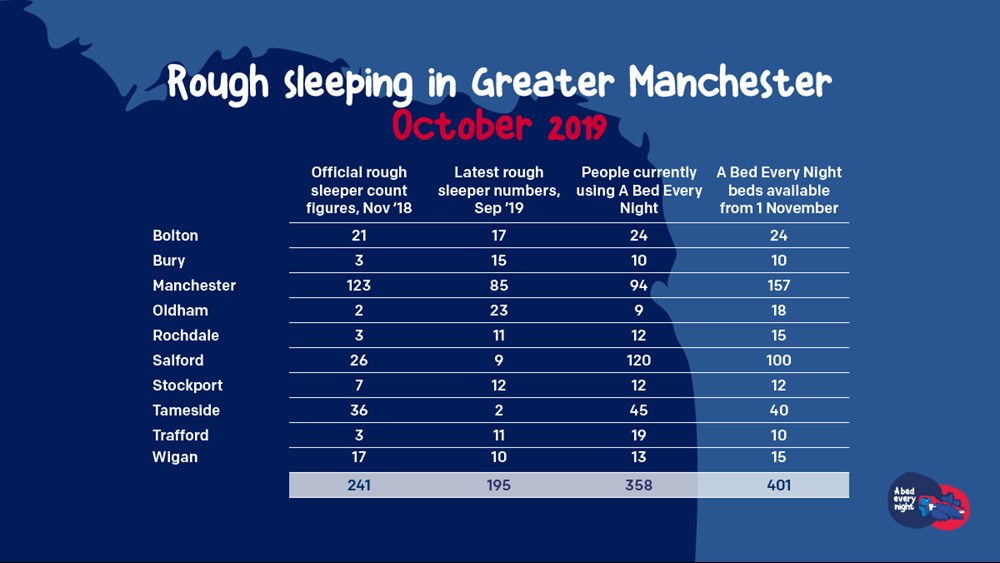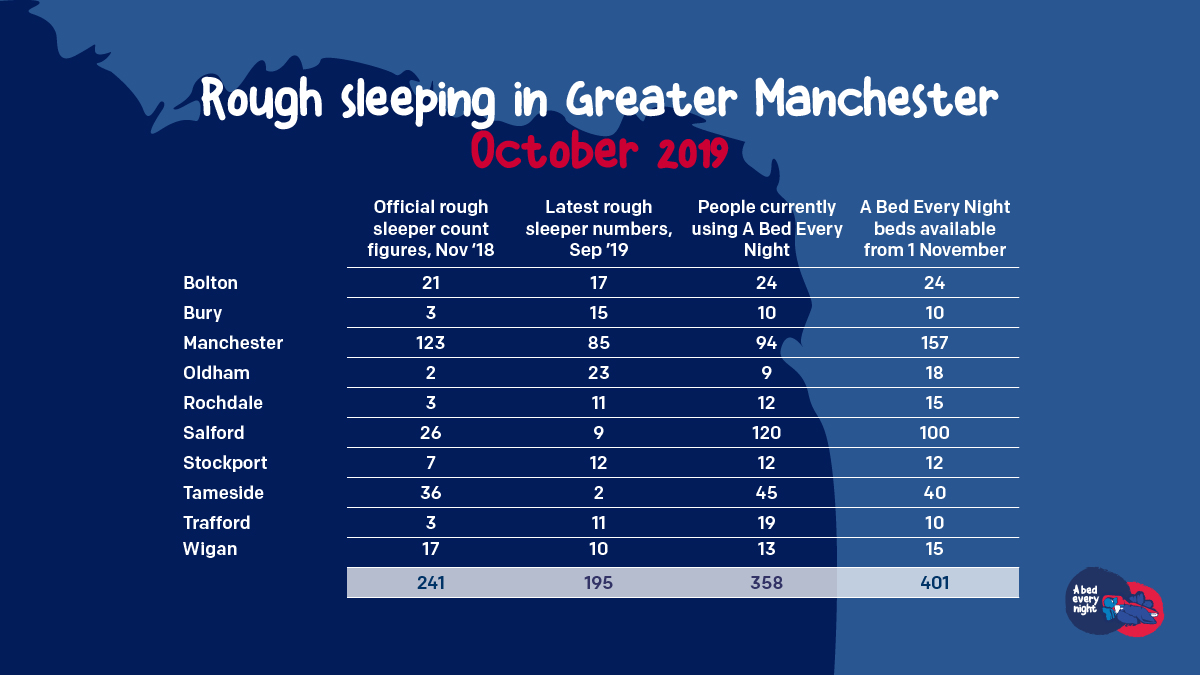
Rough sleeping in Greater Manchester down for second consecutive year – Mayor pledges further action
New figures show that for the second consecutive year the number of people sleeping rough in Greater Manchester has fallen, bucking the previous trend of substantial year-on-year increases since 2010.
The latest data made public by the Greater Manchester Combined Authority (GMCA) shows local councils’ rough sleeper outreach teams recently recorded 195 individuals living outdoors across the 10 boroughs, in contrast to 241 recorded as part of the government’s official rough sleeper count which took place in November 2018.
The latest fall of 19% continues the downward trend first recorded in January with the publication of the official rough sleeper count, which revealed a decrease of 8%, the first time rough sleeping had fallen in Greater Manchester in almost a decade. Since 2010, rough sleeping had been increasing, reaching a high of 268 people in 2017.
As winter approaches and temperatures start to drop A Bed Every Night, the Mayor of Greater Manchester Andy Burnham’s ambitious and ground-breaking scheme aiming to help end the need for rough sleeping in Greater Manchester city-region by 2020, has entered a second more intensive phase. More than 400 beds are due to be ready within a week for people sleeping rough.
With a bigger outreach workforce than ever before, with new data systems to share information and co-ordinate responses, with significant investment in accommodation and support that goes far beyond the statutory duty of local authorities, the city-region is working as one to make a real, sustainable difference.
Andy said: “While fewer people are sleeping rough in Greater Manchester than when I came into office, I am not in any way complacent and know so much more needs to be done. But these figures show that the commitment of our councils and community organisations is making a real difference, and I want to thank everyone for making A Bed Every Night such a strong response to the homelessness crisis.
“As a result, Greater Manchester is entering the coming winter with a stronger set of arrangements for people sleeping rough than we have ever had. We have more places to stay of a better quality and are well on the way towards our goal of ending the need for rough sleeping.”
The latest GMCA data on people sleeping rough in the city-region is as follows:


In total more than 2,200 people have benefitted from A Bed Every Night emergency accommodation since the scheme was launched in November 2018. Since then, individual Greater Manchester boroughs have been effective in assisting people from a life on the streets into emergency accommodation; in Salford 120 people are in A Bed Every Night provision with 9 individuals counted as living outdoors, while in Tameside 45 people are indoors with a fraction of that amount still street homeless.
More than 400 beds will be available at the start of next month, with the largest numbers located in Manchester – which also has the largest rough sleeper population – and Salford. The amount of beds commissioned in districts has been agreed with individual local authorities – they represent the minimum commissioned provision for A Bed Every Night and councils are able to, and frequently do, commission more to meet demand.
In boroughs where those accommodated currently exceeds the number of A Bed Every Night beds, other resources including statutory temporary accommodation and Housing First are being used to meet the needs of people known to be rough sleeping. All boroughs are working hard to source a greater local supply of longer-term accommodation for more established A Bed Every Night customers to move into when appropriate.
Phase 2 of A Bed Every Night is funded through a comprehensive £6m package from a range of partners including the GMCA and with £2 million from the Greater Manchester Health and Social Care Partnership (GMHSCP). As well as improving the quality of accommodation, there will be more training for front-line staff and volunteers and improve signposting, screening and assessment into relevant health services.
A Bed Every Night is just one of a wide variety of schemes and systems supporting people who are homeless, or at risk of becoming homeless, in Greater Manchester. The city-region’s Housing First pilot, backed by £7.6m of government funding, has so far assisted more than 33 of the most entrenched rough sleepers into supported accommodation, while the Social Impact Bond has helped a further 311.
- In March 2018 central government pledged £30 million of Rough Sleeping Initiative (RSI) funding for 2018/19 aimed at supporting local authorities with high levels of rough sleeping. The Greater Manchester proportion of this funding has assisted councils with, among other things, undertaking more regular counts of each boroughs’ rough sleeper populations. Any RSI count is based on a combination of physical counts and informed estimates. The figures detailed in column three of the above table in some cases show a higher proportion of people sleeping rough in certain boroughs than those recorded in November 2018 as part of the official government rough sleeper count. The new data set resulting from RSI counts is believed to be significantly more robust and evidences a reduction in rough sleeping across Greater Manchester of 19% since November last year.
- As per the data set in column three of the above table, not every person recorded as sleeping rough in Greater Manchester in September 2019 will require, or be suitable for, A Bed Every Night emergency accommodation – some will be owed a duty to statutory temporary or supported accommodation, or may be better assisted by the ongoing Housing First or Social Impact Bond programmes.
- As per columns four and five in the above table, certain data may suggest a shortfall of A Bed Every Night spaces in specific boroughs where the current number of individuals accessing A Bed Every Night exceeds the amount of spaces commissioned. Boroughs are working hard with individuals using A Bed Every Night to achieve a successful path into better quality, more long-term accommodation – a truly sustainable future away from homelessness. The number of commissioned beds as highlighted in column five is a sum jointly agreed between local authorities and the GMCA and is anticipated to prove sufficient for the of the forthcoming winter.
- On those occasions when the number of customers requiring A Bed Every Night accommodation exceeds the number of available commissioned spaces across Greater Manchester, for instance surges expected at times of cold weather, local authorities will seek additional emergency accommodation options (so-called A Bed Every Night ‘uplift’) in the local area until such time as a space becomes available within A Bed Every Night emergency accommodation – consequently, the spaces listed in column five of the above table is the minimum available A Bed Every Night provision in any borough at any one time.
Article Published: 24/10/2019 14:43 PM



